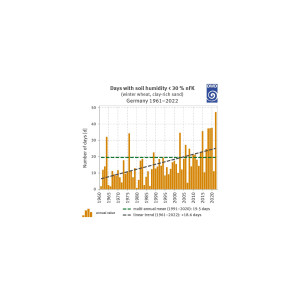Figure 10 to 11 Soil moisture

Figure 10: Soil moisture values - sandy clay (left) Source: DWDThe chart consists of two illustrations – one showing the number of days with soil humidity of less than 30 per cent usable field capacity (nFK) for winter wheat on sandy clay while the other shows – for the same number of days – the comparable value for winter wheat on clay-rich sand, each for the period of 1961 to 2022. The multi-annual mean for the period of 1991 to 2020 for sandy clay amounts to 5.3 days. The linear trend for Germany regarding the period examined amounts to an increase by 8.6 days. The height of the bars increases, albeit with annual fluctuations. Most of the values vary between 0 and 5 days, while peak values lie above 20 days, and the only value above 25 days was recorded for 2022. The multi-annual mean from 1991 to 2022 for clay-rich sand amounts to 19.5 days. The linear trend for Germany regarding the period examined amounts to an increase by 18.6 days. The height of the bars increases, albeit with annual fluctuations. Most of the values vary between 0 and 20 days, while peak values lie above 20 days, and the only value above 40 days was recorded in 2022.

Figure 10: Soil moisture values - clay-rich sand Source: DWDThe chart consists of two illustrations – one showing the number of days with soil humidity of less than 30 per cent usable field capacity (nFK) for winter wheat on sandy clay while the other shows – for the same number of days – the comparable value for winter wheat on clay-rich sand, each for the period of 1961 to 2022. The multi-annual mean for the period of 1991 to 2020 for sandy clay amounts to 5.3 days. The linear trend for Germany regarding the period examined amounts to an increase by 8.6 days. The height of the bars increases, albeit with annual fluctuations. Most of the values vary between 0 and 5 days, while peak values lie above 20 days, and the only value above 25 days was recorded for 2022. The multi-annual mean from 1991 to 2022 for clay-rich sand amounts to 19.5 days. The linear trend for Germany regarding the period examined amounts to an increase by 18.6 days. The height of the bars increases, albeit with annual fluctuations. Most of the values vary between 0 and 20 days, while peak values lie above 20 days, and the only value above 40 days was recorded in 2022.

Figure 11: Annual mean number of days with a soil humidity Source: DWDThe chart consists of two rows of six nationwide maps each of Germany. The top row of maps shows the annual mean number of days with a soil humidity of less than 30 per cent usable field capacity for winter wheat on sandy clay, while the number of days in the bottom row refers to clay-rich sand. The six maps each cover the following periods: 1963–1972, 1973–1982, 1983–1992, 1993–2002, 2003–2012 and 2013–2022. The range for the top row is spread over 5 equidistant categories from 0 days (in shades of green) to the maximum of 30 days (in shades of orange). For the bottom row the range is spread over 5 equidistant categories from 0 to 50 days. Looking towards the right, the maps are increasingly dominated by shades of orange. There is a distinct focal area in the north-eastern part of Germany, and in later years, also in the Rhine area between Stuttgart and Frankfurt. In the bottom row of maps, the orange-coloured areas on the most recent map extend to almost the whole of Germany, except for the south of Bavaria and Baden-Württemberg, the Bavarian/Upper Palatinate forest, the Fichtel Mountains and the Erz Mountains on Germany’s eastern border as well as the western uplands where the areas are still coloured green.

